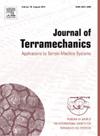UAV-based three-dimensional rough terrain modelling
IF 3.7
3区 工程技术
Q3 ENGINEERING, ENVIRONMENTAL
引用次数: 0
Abstract
Accurate modelling of the interaction between a tyre and the terrain is crucial for successful vehicle dynamics simulation, particularly in challenging off-road conditions. This study introduces a novel approach for obtaining accurate 3D terrain models for vehicle simulation. An unmanned aerial vehicle (UAV) was used to develop three-dimensional terrain models of a various test tracks. These models were compared with measurements obtained from a traditional road profilometer. Excellent correlation between the two measurement approaches is found. The advantages of the UAV method lie in its speed without compromising accuracy and that measurements are immune to the terrain roughness. In contrast to the labour-intensive measurements required by a mechanical road profilometer and subsequent post-processing, the UAV approach requires minimal time and effort. The UAV method is not coupled to the terrain roughness, thus eliminating the drift associated with other ground-based approaches. The UAV method is insensitive to terrain deformation. This opens the door to modelling very rough and even deformable terrains and using these models for vehicle dynamics simulations in extreme off-road environments. Data analysis is prone to many potential pitfalls which can result in highly inaccurate results that are difficult to detect unless a reliable baseline is available for comparison.
基于无人机的三维粗糙地形建模
轮胎和地形之间相互作用的精确建模对于成功的车辆动力学模拟至关重要,特别是在具有挑战性的越野条件下。本研究提出了一种新的方法来获得精确的三维地形模型用于车辆仿真。利用一架无人驾驶飞行器(UAV)建立了各种试验轨道的三维地形模型。这些模型与传统道路轮廓仪的测量结果进行了比较。发现两种测量方法之间具有良好的相关性。无人机方法的优点在于其速度而不影响精度,并且测量不受地形粗糙度的影响。与机械道路轮廓仪和随后的后处理所需的劳动密集型测量相比,无人机方法需要最小的时间和努力。无人机方法不受地形粗糙度的影响,从而消除了与其他地面方法相关的漂移。无人机方法对地形变形不敏感。这打开了大门,建模非常粗糙,甚至可变形的地形,并使用这些模型的车辆动力学模拟在极端的越野环境。数据分析容易出现许多潜在的缺陷,这些缺陷可能导致高度不准确的结果,除非有可靠的基线可供比较,否则很难发现这些结果。
本文章由计算机程序翻译,如有差异,请以英文原文为准。
求助全文
约1分钟内获得全文
求助全文
来源期刊

Journal of Terramechanics
工程技术-工程:环境
CiteScore
5.90
自引率
8.30%
发文量
33
审稿时长
15.3 weeks
期刊介绍:
The Journal of Terramechanics is primarily devoted to scientific articles concerned with research, design, and equipment utilization in the field of terramechanics.
The Journal of Terramechanics is the leading international journal serving the multidisciplinary global off-road vehicle and soil working machinery industries, and related user community, governmental agencies and universities.
The Journal of Terramechanics provides a forum for those involved in research, development, design, innovation, testing, application and utilization of off-road vehicles and soil working machinery, and their sub-systems and components. The Journal presents a cross-section of technical papers, reviews, comments and discussions, and serves as a medium for recording recent progress in the field.
 求助内容:
求助内容: 应助结果提醒方式:
应助结果提醒方式:


